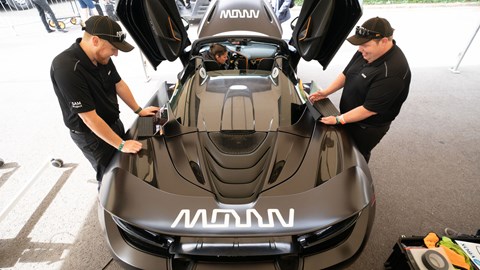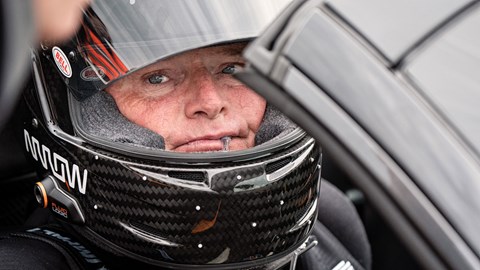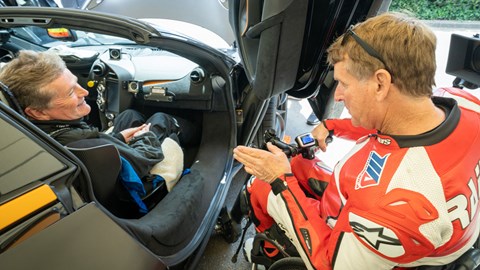► Inside Arrow’s pioneering SAM car projects
► Developed with quadriplegic racing driver Sam Schmidt
► Steer-by-camera system has a future on the road
At the 2021 Goodwood Festival of Speed, one of the biggest cheers of the event went to quadriplegic driver Sam Schmidt, who powered up the hill in a Chevrolet Corvette, steering by moving his head and accelerating and braking with his mouth.
Even more rousing applause followed in 2022 when Schmidt stormed up the hill yet faster in a McLaren 720S Spider, using an evolution of the same ‘SAM car’ system.
Want to access more amazing content from CAR? Become a member of CAR VIP here with a 99p trial!
CAR caught up with Josh Willis, field applications engineer and project lead on the SAM system at Arrow, the technology company behind it, to find out where it began, how it’s evolved and where it could be going next.

Where it began
SAM car stands for Semi-Autonomous Motorcar and Arrow began initial work on the project in 2013.
‘Arrow is an electronics company that enables other companies to make products – we’re not a car company,’ Willis explains. ‘We wanted to show our partners and suppliers what our engineers are capable of. Arrow was brainstorming [ways to do that] – and this idea came out.
‘We had a contact at Denver hospital, with expertise in paraplegic and quadriplegic injuries. He recommended Sam.’
Sam Schmidt is a race-winning Indycar driver (and subsequently team owner) who suffered a severe spinal cord injury during a crash in Orlando in 2000.
‘One of Sam’s first questions was, “How fast are we aiming to go?”’ Willis says. ‘He said, “I’m not interested if we’re not going to go above 100mph. Anything below that is just a faster wheelchair…”’
As it turned out, Schmidt would top 100mph on the system’s test debut at the Indianapolis Speedway. He’s since gone faster than 200mph…
Arrow’s initial system, trialled in a front-engined Corvette at Indy, involved wearing a baseball cap with reflective markers, tracked by four infrared cameras and linked to off-the-shelf software ordinarily used for animation and athlete body training. When Schmidt leaned his head left or right, the data from the cameras was fed to an actuator on the car’s steering.
In a similar way, acceleration was by Schmidt tilting his head backward, and braking by biting on a sensor between his teeth.

Where it’s gone
For SAM 2.0, the system evolved in ways including:
- A single mouth device for acceleration and braking, a tube setup which can be blown into: ‘Puff for gas, sip for brake,’ Willis explains. ‘It’s based on pressure, not airflow, so if the driver’s cheeks get tired, they can blow into tube and bite it, and that maintains the throttle pressure.’
- The reflective dots were moved from a hat to sunglasses. (‘Or a helmet,’ Willis explains: ‘You just need a surface rigid enough for the markers.’)
- The steering actuation developed to allow more lock for tighter turns, and changed from tilting the driver’s head into the corner –a natural thing to do on an oval racetrack – to rotating the head: you look where you want to go. (‘We’ve put in a deadzone so it’s easier for Sam to go back to centre, and you can adjust the steering map depending on the type of course, driver preference and so on, Willis says. ‘If you draw a graph of the steering response it’s like a U-shape, with the response ramping up for a hairpin or similar.’)
Hairpins such as those at Pikes Peak. In 2016, Sam Schmidt drove to the summit in 15 minutes (just over six minutes behind the overall winner of that year’s International Hill Climb), hitting 80mph on the way.
‘Going to Pikes Peak from the original drives on Indianapolis Super Speedway where there’s lots of space was like going from a five-lane freeway to a two-lane road,’ says Willis, who sat alongside Schmidt during test runs on the hillclimb before Pikes Peak legend Robby Unser took over the co-driver’s seat for the timed runs. ‘We fitted full dual controls, so the co-driver could take over in an emergency. That included a second, electric steering wheel – almost like the kind of wheel you would use on a racing sim.
In 2020, Schmidt returned to racing for the first time, in the third SAM car, now a mid-engined Corvette C8.
‘Sam wanted to enter some autocross racing, and he finished 20th out of 35 drivers in highly tuned cars in his second event,’ he continues. ‘One of the biggest challenges is holding Sam’s body up in the seat – he has no core strength, and we’ve had to develop different cushioning solutions.’
Goodwood Festival of Speed 2022 marked the SAM system’s seventh year and its fourth car: now a McLaren 720S, in line with Arrow’s association with McLaren (and Sam Schmidt’s Arrow McLaren SP IndyCar team).
The evolution of the system in the McLaren involves two stereo cameras down by the glovebox, rather than the original four-camera system.

CAR caught up briefly with Sam Schmidt as he prepared to get aboard the McLaren for one of his runs up the hill. He’s taking it as seriously as you would expect of a pro racing driver.
‘I want to be competitive,’ he says. ‘Based on tests, I don’t think we can go much faster; you can’t get the tyres warm here. We’ve done some fine-tuning of the system because of the carbon brakes; first time I drove it, it was extremely grabby.
‘If the car slides, I can feel it, and it’s a lot of fun.’
‘He’s quick,’ smiles his co-driver (and also a racing driver), McLaren’s Fred Martin-Dye, who doesn’t look at all nervous. You get the sense Schmidt is as safe as he is swift.
Where it’s going next
‘The system is now legal on the road in the USA, Sam has a road licence and drives a car fitted with the system on the road at home,’ Willis says.
‘Arrow is willing to give this technology away for free to any company that wants to try to productionise it and take it to market,’ he continues. ‘It’s a good thing that the customer base is so small but that also makes it a challenge to take on. The [ultimate] aim is to have a plug-in cable, one-box solution.’
To realise that is a huge challenge but the potential is exciting: ‘We’re also working on an AI-based approach to replace the camera system. We demonstrated the system for the first time at Goodwood Motor Circuit and it could be a gamechanger once it’s validated for use at high speeds, and if we can miniaturise it into a cost-effective solution.’

Some of the data involved is head-scrambling; quite literally in some ways, as the system has to be capable of the equivalent of reading hundreds of thousands of images of a driver’s head from every degree in different axes. In fact, to teach the AI software to track a driver’s head, Arrow had a prosthetic head made by a Hollywood prop company to test the software.
In a separate project, Arrow has also developed a semi-autonomous exoskeleton SAM Suit, allowing Sam to stand and walk short distances, and is continuing to work on advancing exoskeleton technology for users with high-level spinal cord injuries.
The emotional applause that met Sam Schmidt at the top of Goodwood Hill is a reminder of engineering’s power to change people’s lives – and the car as a literal and metaphorical vehicle to continue pushing at the boundaries of technology.